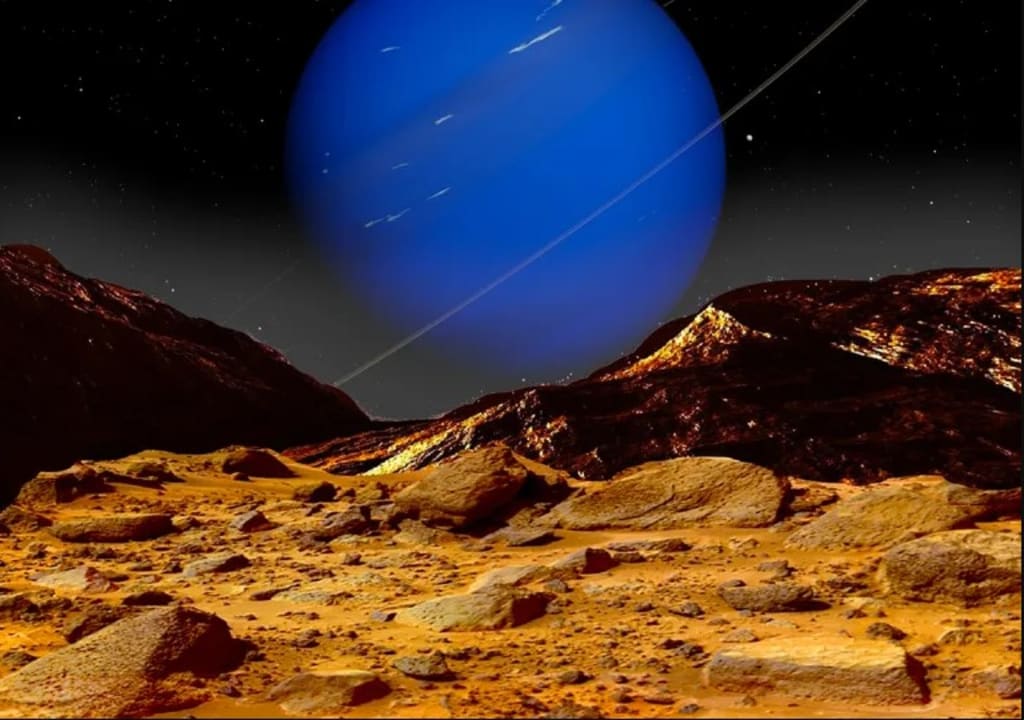Planet Neptune
Neptune is the eighth and farthest planet from the sun in our solar system. It was discovered on September 23, 1846 by mathematician Urbain Le Verrier and astronomer Johann Galle.

Neptune is the eighth and farthest planet from the sun in our solar system. It was discovered on September 23, 1846 by mathematician Urbain Le Verrier and astronomer Johann Galle.
Neptune is a gas giant, similar to Uranus, and is the fourth largest planet in our solar system. It has a diameter of approximately 49,244 kilometers and a mass 17 times greater than Earth. Neptune has a very active atmosphere with powerful winds that reach up to 2,000 kilometers per hour, making it the windiest planet in our solar system.
The atmosphere of Neptune is composed primarily of hydrogen, helium, and methane, which gives the planet its blue color. The blue color is a result of the way that methane absorbs red light, allowing only blue light to reach our eyes. Additionally, Neptune has several cloud formations, including white clouds that are composed of frozen methane.
Neptune has 13 known moons, the largest of which is Triton. Triton is unique because it is one of the few moons in our solar system that orbits in a retrograde direction, meaning it orbits in the opposite direction of its planet's rotation. Triton also has a very thin atmosphere, active geysers, and a surface that is covered in ice.
The interior of Neptune is thought to have a rocky core surrounded by a mixture of ice and gas. The planet also has a strong magnetic field that is tilted at an angle of 47 degrees relative to its rotation axis. This magnetic field helps to protect Neptune from the solar wind and cosmic rays.
One of the most interesting features of Neptune is the Great Dark Spot, which was first observed by the Voyager 2 spacecraft in 1989. The Great Dark Spot was a large, circular storm that was similar in size to Earth. However, subsequent observations by the Hubble Space Telescope have shown that the Great Dark Spot has disappeared and that Neptune has several other similar storms.
Despite its distance from the sun, Neptune still receives some heat and energy from the sun, which drives its weather patterns. In fact, Neptune has some of the most intense weather in our solar system, including massive storms, bright clouds, and powerful winds.
Neptune also has a number of unique features that set it apart from other planets in our solar system. One such feature is its rings, which are made up of small particles of ice and rock. These rings are very difficult to see from Earth due to their faintness and small size.
Another unique aspect of Neptune is its extreme seasons. Due to its long orbital period of 165 Earth years, each of its seasons lasts for over 40 Earth years. During its summer, Neptune's southern hemisphere is exposed to constant sunlight, while its winter is characterized by long periods of darkness.
Neptune is also a source of intense radiation, particularly in the form of radio waves. These radio waves are generated by the interaction between the planet's magnetic field and the charged particles that make up its atmosphere. This radiation is so intense that it can even affect the orbits of Neptune's moons.
Despite its many interesting features, Neptune remains one of the least explored planets in our solar system. This is due to its great distance from the sun and its relatively small size, which makes it difficult to observe from Earth. However, with the help of modern technology and space probes, scientists are continuing to learn more about this fascinating planet and its many mysteries.
In recent years, there has been increased interest in the study of Neptune and its potential as a target for future space missions. Scientists believe that the study of Neptune could provide valuable insights into the evolution and structure of our solar system, as well as the formation and evolution of gas giants in general.
In conclusion, Neptune is a fascinating and mysterious planet that continues to intrigue scientists and the general public alike. With its active atmosphere, diverse moons, and unique characteristics, it is clear that Neptune is a truly remarkable planet in our solar system.
Translated by: Georgenes Medeiros
Source: OpenAI.com
About the Creator
Georgenes Medeiros
53 years old, divorced, graduated in Business Administration, writer, translator, available for new challenges.
Despite everything still in search of a soul mate.
If it's you call me....






Comments
There are no comments for this story
Be the first to respond and start the conversation.